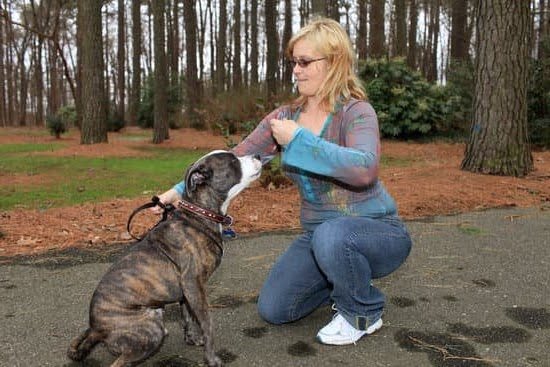Training for dogs is an essential part of responsible pet ownership. From teaching basic commands to addressing behavioral issues, training plays a crucial role in the well-being of your canine companion. It is important to understand the importance of training for dogs and how it can positively impact their behavior and overall quality of life.
As a dog owner, understanding the basic principles of dog training is key to effectively communicating with your furry friend. By learning about different training methods and techniques, you can set realistic expectations for your dog’s behavior and tailor your approach to suit their individual needs.
Choosing the right training method for your dog is essential in ensuring successful outcomes. Whether it’s positive reinforcement, clicker training, or obedience classes, finding the right approach can make a significant difference in your dog’s progress and overall happiness. In this article, we will explore various training methods and how to determine which one is best suited for your dog.
The Basic Principles of Dog Training
One of the fundamental principles of dog training is positive reinforcement. This involves rewarding your dog with treats, praise, or toys when they exhibit the desired behavior. Positive reinforcement helps to motivate and encourage dogs to repeat good behavior. It is important to use rewards that are valuable to your dog and to give them immediately after they perform the desired action.
Consistency is another crucial principle in dog training. Dogs thrive on routine and consistency, so it’s important to set clear rules and expectations for their behavior. Consistent training methods and cues help dogs understand what is expected of them, leading to quicker learning and better obedience. Inconsistency can confuse dogs and make it harder for them to learn what is required of them.
Another important principle of dog training is patience. Every dog learns at its own pace, so it’s essential for owners to be patient and persistent with their training efforts. Rushing or becoming frustrated during training sessions can have a negative impact on a dog’s willingness to learn and comply with commands.
| Principles | Description |
|---|---|
| Positive Reinforcement | Rewarding desired behavior |
| Consistency | Setting clear rules and expectations |
Choosing the Right Training Method for Your Dog
When it comes to choosing the right training method for your dog, it’s important to consider a few key factors. Every dog is unique, so what works for one may not work for another. The first step in choosing the right training method for your dog is to consider their personality, breed, and individual needs. For example, some dogs respond well to positive reinforcement training, while others may require more structure and firm guidance.
Another important factor to consider when choosing a training method for your dog is your own lifestyle and schedule. Some methods may require more time and consistency than others, so it’s crucial to choose a method that aligns with your ability to dedicate time and effort to the training process.
It’s also essential to consider any specific behavior issues or challenges that your dog may have. For example, if you’re dealing with aggression or anxiety, you’ll want to choose a training method that specifically addresses these issues. Additionally, if your dog is a working breed or has high energy levels, you’ll want to choose a method that provides them with the physical and mental stimulation they need.
Lastly, finding the right trainer or training program for your dog’s needs can be incredibly beneficial. A professional trainer can assess your dog’s behavior and create a tailored training plan that addresses their unique needs. Whether you choose group classes or private sessions, having expert guidance can make all the difference in the effectiveness of your dog’s training.
| Key Factors | Considerations |
|---|---|
| Personality, breed, and individual needs | Adaptability of chosen method |
| Lifestyle and schedule | Time and consistency required by method |
| Specific behavior issues or challenges | Fitness of method in addressing issues |
Essential Commands Every Dog Should Learn
When it comes to training for dogs, there are several essential commands that every dog should learn. These commands not only help to establish a good relationship between the owner and their pet but also ensure the safety and well-being of the dog. Whether you have a new puppy or an older dog, teaching these basic commands is crucial for their overall training and development.
Sit, Stay, and Come
One of the most important commands for any dog to learn is “sit”. This command not only teaches them to be calm and in control but also sets the foundation for other commands. “Stay” is another crucial command as it ensures that your dog will stay in place when instructed, which can be a life-saving command in certain situations. The “come” command is essential for calling your dog back to you when needed, especially in emergency situations.
Heel and Leave It
“Heel” is a crucial command for walking your dog on a leash without pulling or tugging. Teaching your dog to “leave it” can prevent them from picking up harmful objects or food while on walks or in unfamiliar environments. Both of these commands are essential for the safety of your pet as well as the convenience of everyday activities.
Down and Off
Teaching your dog to “down” can help them relax and stay calm in various situations. The “off” command is crucial for preventing jumping on people or surfaces. Both of these commands are important for creating a well-mannered and polite pet that can interact with people and other animals appropriately.
By focusing on these essential commands during training sessions, owners can create a strong foundation for their dogs’ overall obedience and behavior. Constant practice and consistency are key factors in effectively teaching these commands, ensuring that your furry friend becomes a well-behaved member of the family.
Training Tips for Dealing With Common Behavior Issues
Dealing with common behavior issues in dogs can be frustrating and challenging. Whether it’s excessive barking, jumping on people, or pulling on the leash during walks, these issues can make it difficult to enjoy time with your furry friend. However, with the right approach and consistency, many of these issues can be resolved through training for dogs.
Here are some training tips for dealing with common behavior issues:
- Consistency is Key: Dogs thrive on routine and consistency, so it’s important to establish clear rules and boundaries for your dog. Make sure everyone in the household is on board with the training plan and enforces the same rules.
- Positive Reinforcement: Use positive reinforcement techniques such as treats, praise, and toys to reward your dog for good behavior. This will help reinforce the desired behavior and make training more enjoyable for your dog.
- Redirecting Behavior: If your dog exhibits undesirable behavior, such as jumping on guests, instead of scolding them, redirect their attention to a more appropriate behavior, such as sitting or lying down.
By incorporating these training tips into your daily routine, you can effectively address common behavior issues and create a harmonious relationship with your beloved canine companion. Remember that patience and consistency are key when it comes to training for dogs.
The Role of Positive Reinforcement in Dog Training
Positive reinforcement is a key element in dog training, as it focuses on rewarding and encouraging good behavior rather than punishing bad behavior. This method involves giving your dog something they enjoy, such as treats, praise, or playtime, to reinforce the desired behavior. Positive reinforcement has been shown to be more effective and less stressful for dogs compared to punishment-based methods.
Here are some essential tips for implementing positive reinforcement in your dog training:
- Use high-value treats: Find out what treats your dog loves the most and use them as rewards for good behavior during training sessions.
- Be consistent: Always reward the behavior you want to see more of, and ignore or redirect unwanted behavior without punishing your dog.
- Use verbal praise: Pairing treats with verbal cues such as “Good boy.” or “Good girl.” can reinforce the positive association with the desired behavior.
It’s important to note that positive reinforcement should be used in conjunction with other training techniques and should be tailored to your dog’s individual personality and learning style. When done correctly, it can help create a strong bond between you and your furry friend while effectively teaching them new commands and behaviors.
In addition to shaping good behavior, positive reinforcement can also help build confidence in shy or anxious dogs and improve their overall well-being. By focusing on rewarding the positive actions of our canine companions, we can create a harmonious and enjoyable training experience for both them and us.
Advanced Training Techniques for More Challenging Dogs
Advanced training techniques are essential for dogs that are more challenging to train. These dogs may have behavioral issues, difficulty focusing, or high energy levels that require a different approach to training. It’s important to understand the specific needs of your dog and tailor the training methods accordingly.
Socialization and Desensitization
For more challenging dogs, socialization and desensitization are crucial components of their training. Exposing the dog to different environments, people, and other animals in a controlled manner can help reduce fear and anxiety. Desensitization involves gradually exposing the dog to stimuli that trigger their negative reactions, such as loud noises or unfamiliar objects, in order to change their response over time.
Targeted Reinforcement Techniques
Using targeted reinforcement techniques, such as differential reinforcement of alternative behavior (DRA) or shaping, can be effective for more challenging dogs. DRA involves reinforcing an alternative behavior to replace an undesirable one, while shaping involves gradually molding a desired behavior by rewarding small steps towards it.
Consistency and Patience
Consistency and patience are key when using advanced training techniques for challenging dogs. It’s important to set clear expectations and boundaries, while also being patient and understanding of the time it may take for the dog to learn new behaviors. Rushing through the process can lead to frustration for both the dog and the trainer.
Implementing these advanced training techniques requires dedication and commitment from the trainer. With patience, consistency, and specialized methods tailored to their needs, even the most challenging dogs can make significant progress in their training journey.
By incorporating these advanced training techniques into your dog’s training regimen, you can address their specific needs effectively and help them become well-behaved companions.
The Benefits of Obedience Training for Dogs of All Ages
Obedience training for dogs is an essential aspect of ensuring a well-behaved and well-adjusted pet. Whether you have a new puppy or an older dog, obedience training offers numerous benefits for both the dog and the owner.
One of the main advantages of obedience training is that it creates a strong bond between the dog and its owner. Through consistent and positive reinforcement, dogs learn to trust and respect their owners, leading to a harmonious relationship built on mutual understanding.
Furthermore, obedience training helps in keeping dogs safe in various situations. Teaching basic commands such as “sit,” “stay,” “come,” and “drop it” can prevent accidents and keep the dog out of harm’s way. These commands are particularly crucial when outdoors or in potentially dangerous situations at home. Moreover, obedience training also contributes to a well-behaved and socialized dog, making it easier to introduce them to new people, pets, and environments without fear or anxiety.
Another benefit of obedience training for dogs of all ages is the mental stimulation it provides. Training sessions engage the dog’s mind, prevent boredom, and enhance their overall psychological well-being.
This mental stimulation is especially important for older dogs as it can help reduce cognitive decline and keep them sharp as they age. Overall, obedience training plays a significant role in improving the quality of life for dogs by providing them with structure, mental enrichment, safety, and a strong bond with their owners.
Finding the Right Trainer or Training Program for Your Dog’s Needs
In conclusion, finding the right trainer or training program for your dog’s needs is essential to ensure that they receive the best possible education and guidance. Whether you have a puppy or an older dog, it’s never too late to start training and there are numerous options available to suit every dog and owner’s preferences.
By understanding the importance of training for dogs and the fundamental principles of dog training, you can make an informed decision when choosing the most suitable method and trainer for your furry friend.
When considering different training programs or individual trainers, it’s important to take into account their experience, qualifications, and methodology. Look for trainers who use positive reinforcement as a primary technique, as this has been shown to be the most effective and humane approach to training for dogs. Additionally, consider their expertise in dealing with specific behavior issues or advanced training techniques if your dog requires more intensive instruction.
Ultimately, investing in proper training for dogs will not only benefit their behavior and obedience but also enhance the bond between you and your pet. With dedication and the right guidance, both you and your dog can enjoy a fulfilling journey towards better communication and understanding. So don’t hesitate to seek out the right trainer or training program that will provide your dog with the necessary tools to become a well-behaved and happy companion.
Frequently Asked Questions
What Are the 5 Golden Rules of Dog Training?
The 5 Golden Rules of Dog Training are consistency, positive reinforcement, patience, proper timing, and realistic expectations. Consistency is key in teaching your dog what behavior is acceptable.
What Is the Best Training Method for Dogs?
The best training method for dogs is using positive reinforcement techniques. This means rewarding your dog for good behavior rather than punishing them for bad behavior. Positive reinforcement has been shown to be effective and promotes a strong bond between the owner and the dog.
What Are the 7 Most Important Dog Commands?
The 7 most important dog commands are sit, stay, come, heel, down, off, and leave it. These commands are essential for controlling your dog in various situations and ensuring their safety. Teaching these commands also helps to establish a clear line of communication between you and your pet.

Welcome to the blog! I am a professional dog trainer and have been working with dogs for many years. In this blog, I will be discussing various topics related to dog training, including tips, tricks, and advice. I hope you find this information helpful and informative. Thanks for reading!





